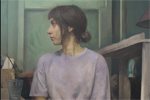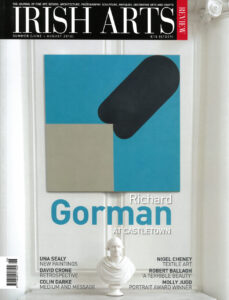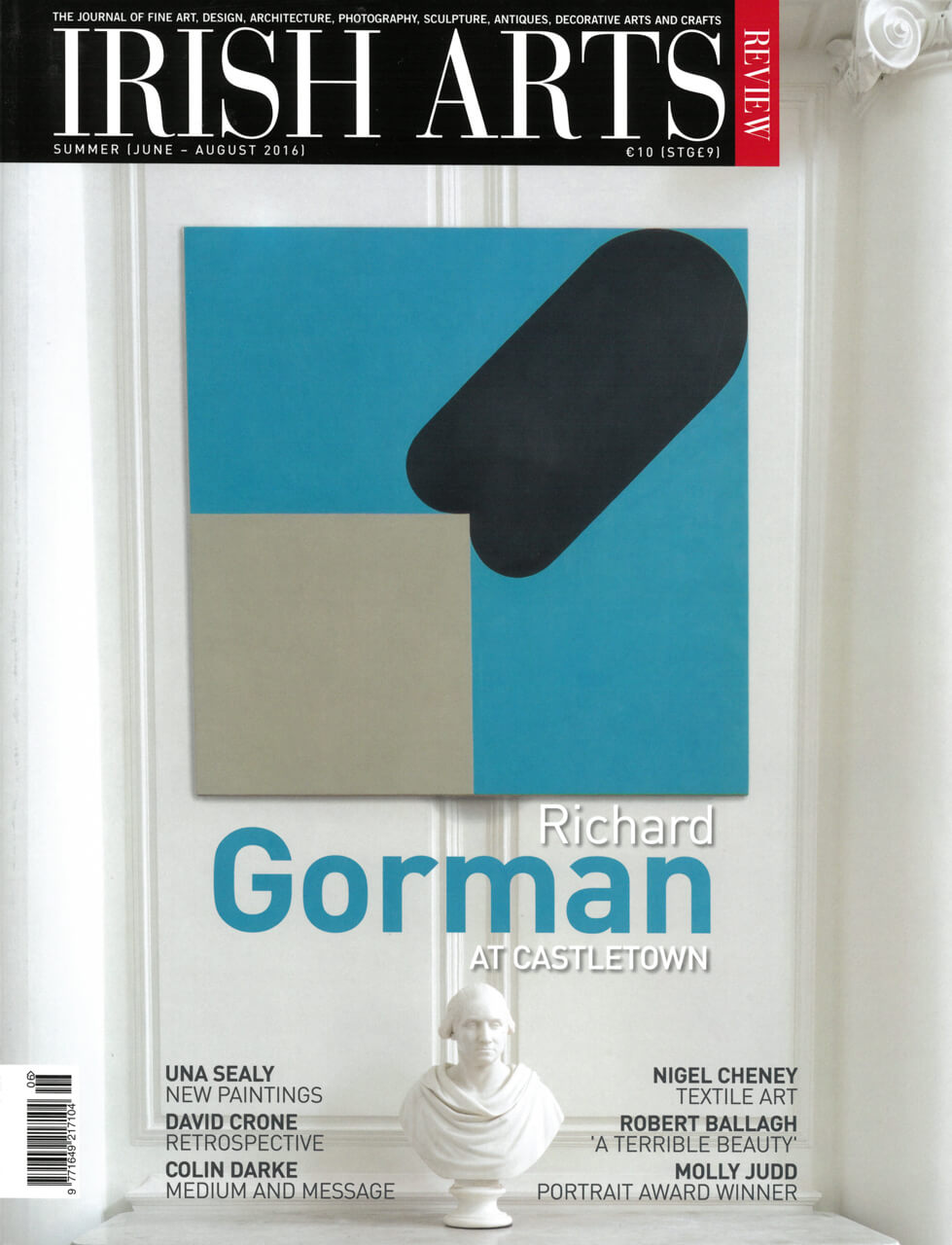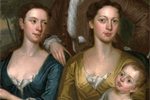

Impressively executed and unsettling in effect, Molly Judd’s Murmuring Lights, is a worthy winner of this year’s Ireland-U.S. Council/Irish Arts Review Portraiture Award, writes Donal Maguire.
In Molly Judd’s Murmuring Lights a dreary, characterless interior is illuminated by the cold light of fluorescent strip bulbs, the sound of which has inspired the painting’s title. The exposed pillars and concrete beams, and the unfinished walls and floors, suggest this is a space designed for industrial, nondomestic functions rather than human habitation. Yet, it is stocked with items of used domestic furniture. Seemingly discarded here, some have been piled-up with other detritus and pushed-back against the wall to clear the floor area. Other items retain a certain autonomy, positioned more purposefully within the space or arranged haphazardly, perhaps to serve some specific but unapparent purpose. A simple slat-back chair stands alone while a metal framed table, a kitchen chair, a squat sideboard holding a table lamp form an uncertain grouping in the middle of the composition. This archipelago of objects is linked together by a power cable that traverses its way in loops and tangles along the floor connecting the lamp to a socket located somewhere out of view. In its differing and incongruent elements the setting is both familiar and strange, the atmosphere claustrophobic yet secure, and the overall effect unsettling yet calming. At the centre of this pictorial paradox is the figure of a young women. Who she is, and why she is there, is not clear, yet her pose, appearance and general demeanour reflect, conform to and blend with that of her surroundings.
Judd’s compelling and impressively executed painting is currently on display at the 186th RHA Annual Exhibition and is the winner of the Ireland-U.S. Council/Irish Arts Review Portraiture Award. A wonderful achievement in itself, Judd has also been awarded the exhibition’s prestigious Hennessy Craig Scholarship (shared with Shane Berkery), also for Murmuring Lights, becoming the first artist to win both prizes. Portraiture is a significant genre in the history of Irish art and has traditionally been regarded highly within the Academy with many of its senior members having excelled at the art form including the current President, Mick O’Dea. Over the decades, the Annual Exhibition has been an important and popular venue for the public display and consumption of portraits and the exhibition continues to provide a good reflection of the current state of the discipline in this country. Judd’s painting was selected from a strong display of portraits that includes works by Diarmuid Breen, Eoghan McGrath, Patrick Redmond and Cian McLoughlin.
Established in 2006, the portrait prize was created to ignite greater interest in the portraits displayed at the exhibition, and to support artists who explore and expand its role and potential within contemporary society. Significantly RHA Council members are not eligible for the award, ruling out competition from more established portraitists, and focusing the award on emerging talent. Previous winners include Maeve McCarthy, Gary Coyle and Geraldine O’Neill, whose diverse practices, as does Judd’s, attest to the award’s goal of promoting and encouraging artists working across the genre’s various modes.
Portraiture is traditionally focused on the representation of an individual personality, and while the subject in Judd’s picture is anonymous, her identity is significant in the creation of the picture. After passing Molly (both the artist’s and sitter’s name) on a Dublin street and captivated by her appearance, Judd went back to find her and to ask her to sit for the painting. There is an interesting dichotomy here around individuality and anonymity. Indeed, in its stark colouring, narrow perspective, moody atmosphere, and psychological undertones, Murmuring Lights suggests various themes relating to individuality within a contemporary urban environment. Most notably, it evokes a sense of isolation, confinement, and introspection, states of mind that are potently symbolized in the robust structure of the interior setting, which appears to be shut-off from the influence or interference of the outside world. Whether this is a space of retreat or one of captivity, however, is unclear.
The young woman looks to be strong and independent and while there is nothing sinister seemingly at play, subtle contradictions in her behaviour and appearance invite further interpretation. Dressed comfortably she exudes an air of detachment and disinterest, yet, looking to her right, her attention is drawn to something in the room that is beyond our view – something that only she can see. Perhaps it is a momentary glance, or a means of avoiding the viewer’s gaze – either way she certainly seems aware of our (the viewer’s) presence. The subtleties of her body language suggest a degree of discomfort and anxiety with this position of being caught here, between the viewer (or the artist) and the wall of furniture. The illusion of a connection between the subject and the viewer is a device of representational art that has been employed by artists from Johannes Vermeer to √âdouard Manet. Indeed, in keeping with the traditions of these great artists, Judd’s picture raises more questions than it answers. Its narrative and psychological ambiguity encouraging us to look beyond its mimetic representation to explore the more symbolic and expressive possibilities of its pictorial content.
Murmuring lights is a fine example of what contemporary representational painting can achieve. Yet Judd’s abilities here should not be taken too lightly particularly as much of this form of representational art in Ireland today is often not very good, too illustrative or even fetishistic. Her facility to represent the physical world is the result of a strict artistic training in a method of art education that, while once popular, is now often viewed as academic and archaic. Attending the Florence Academy of Art, Judd applied herself to a rigorous course of training, the Charles Bargue Method, which focused on developing her skills in the mimetic representation of the natural world – training her eyes, as she explains, ‘to see something in 3D and replicate it in 2D’. Developed in the 19th century, the Bargue method followed in the traditions of the Old Masters and was taught in art schools across Europe. Pupils advance from copying examples of their teachers to drawing from plaster casts before finally advancing to the life room. Judd followed this with a further eighteen months months working in the studio of Norwegian artist Odd Nerdrum where she fulfilled the traditional role of pupil to a master.
Although based on traditional ways of seeing, and academic approaches to materials and representation, Judd seeks to transcend the illustrative and imitative aspects of representational art and to engage with themes and concepts relating to contemporary life. Her training simply equips her with the skills and techniques required to represent the world as she herself sees it. With the great diversity of techniques and methods used by artists today, Judd’s work shows that those of the past can continue to provide artists with an effective means of capturing, exploring, and expressing the world of today.
The RHA 186TH Annual Exhibition, RHA, Dublin until 11 June 2016.
Donal Maguire manages the ESB Centre for the Study of Irish Art at the NGI.



